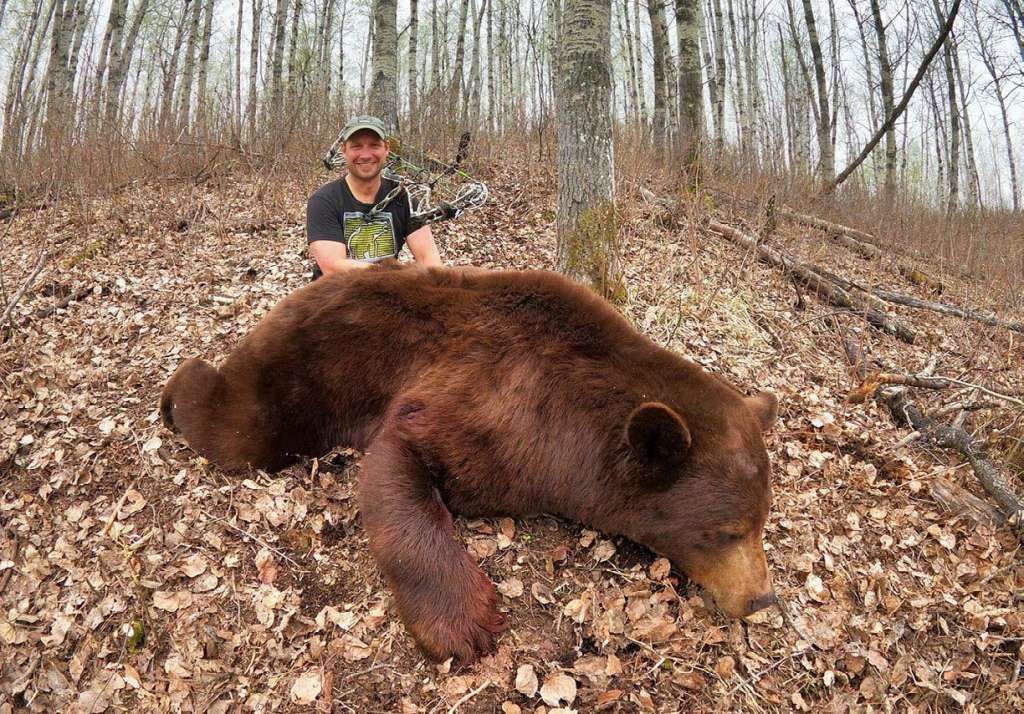Few activities are as rewarding as observing wild bruins up close, deep in the woods in their natural surroundings. Harvesting an animal with primitive hunting equipment like a bow and arrow is an item many have on their bucket list.
When observing wild bears up close and hunting them with primitive equipment like a bow and arrow, it’s important to note that this is a challenging activity that requires proper planning and execution. Baiting for black bears during spring in western Canada can be rewarding, but it requires hard work to ensure success. That includes the work of finding a good location with resident bears, setting up a quality bait station, establishing a good shooter setup and using an effective recipe to attract and hold bears for ethical shots. Follow through on those four elements and you’ll have a bear rug in no time.
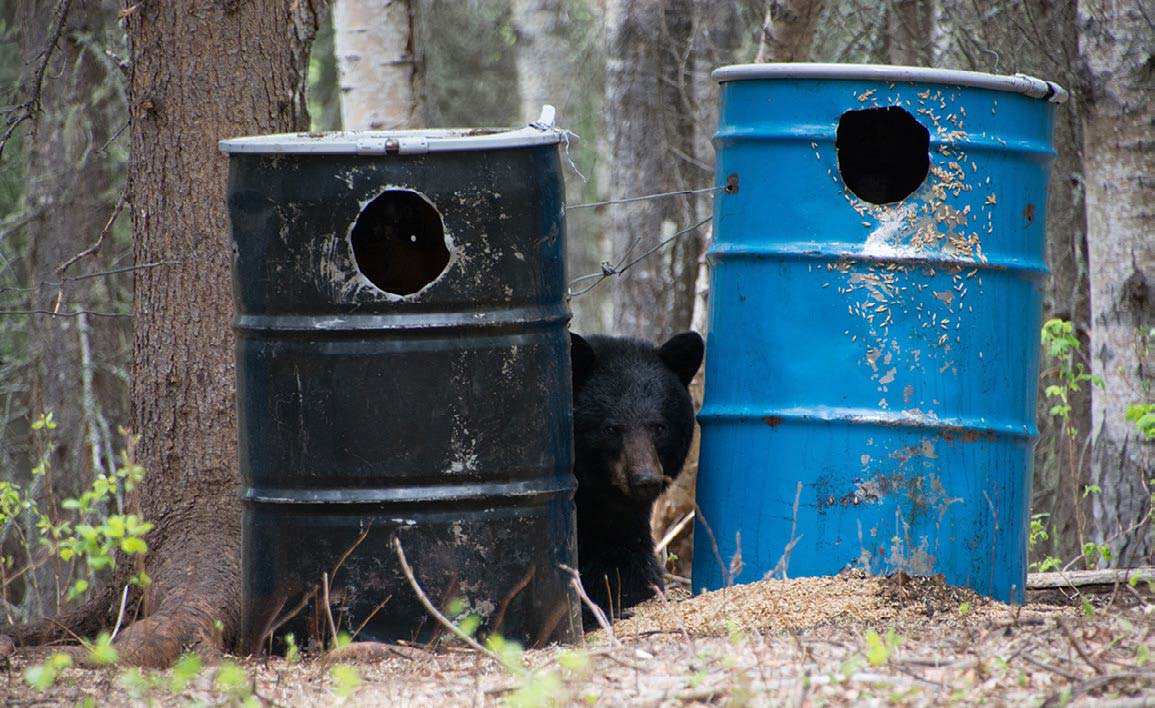
Location
Location is by far the most critical element to consider. There’s no point in investing time, work and money into locations that don’t have healthy bear populations. The goal of baiting is to attract bears from resident stable grounds using strong, appealing smells and copious calories to turn them into predictable returning eaters.
The first step in determining viable bear baiting areas is to start broadly, having a large high-probability area in mind by reviewing government and industry reports and regulations. You’ll want to look for information such as Wildlife Management Units (WMU) where baiting is allowed; the total estimated population of black bears; and total black-bear harvest. Although statistics are important, focus on areas with legal baiting WMUs with high bear densities for the best-starting odds. Other things to consider are hunting seasons, tag quotas, outfitter allocations and special regulations. If possible, strongly consider an area that you can hunt every year without the hindrances of limited draws. Hunting the same spot year after year gives you a superb advantage because you can keep a journal of bear sightings and activities. This recorded information will be invaluable in coming years.
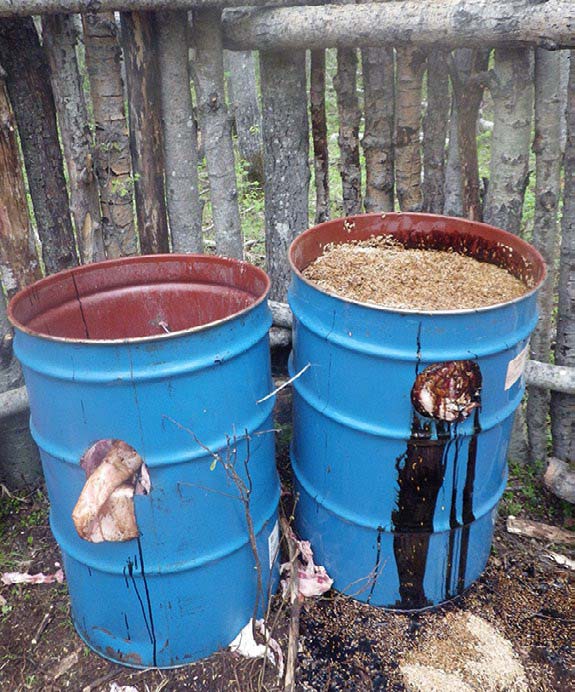
Information
Once you’ve selected a WMU to hunt, your focus can turn to finding promising bear habitats. You can do this by reviewing topographical maps and satellite imagery that is available free from Google Earth. Seek out low, cool grounds along river systems or marshes bordering abundant food sources such as planted cereal crops (like oats) or natural forage patches of berries or clover. Sometimes you’ll even get lucky with the imagery and be able to review photos taken during the late fall or winter. Those will show which cover is sparse versus which is heavy thick timber.
Before you head afield, talk to wildlife biologists, trappers, officers, industry workers, outfitters and bush pilots who are familiar with the area you’re pursuing. These people will know the area best and are often willing to share key intelligence with outdoorsmen who are respectful and courteous. Contact them to discuss noted key areas you’ve discovered by analyzing maps and aerial photos. Often, these discussions can point you to other places you may have overlooked or just not have seen. Just because your initial focus was in one particular area doesn’t mean there aren’t other places to explore. It’s always good to have alternative plans in case your primary location doesn’t pan out.
After deciding on likely areas, it’s time to confirm your speculation, roll your truck odometer forward and put some miles on your boots. Once aground, look for trails alongside river systems in valleys and over ridges. Bears also like to live in low-lying marshy areas, assuming abundant food is nearby. Look for indicators like claw marks on trees and scat. Beavers are a favorite food of bears, so targeting areas having beaver activity can produce excellent results for two reasons. One is the presence of beavers. The other is that those areas tend to green up first, providing plant material to munch on. Establishing baits in areas where bears move naturally makes it that much easier to attract them to your bait station for a shot.
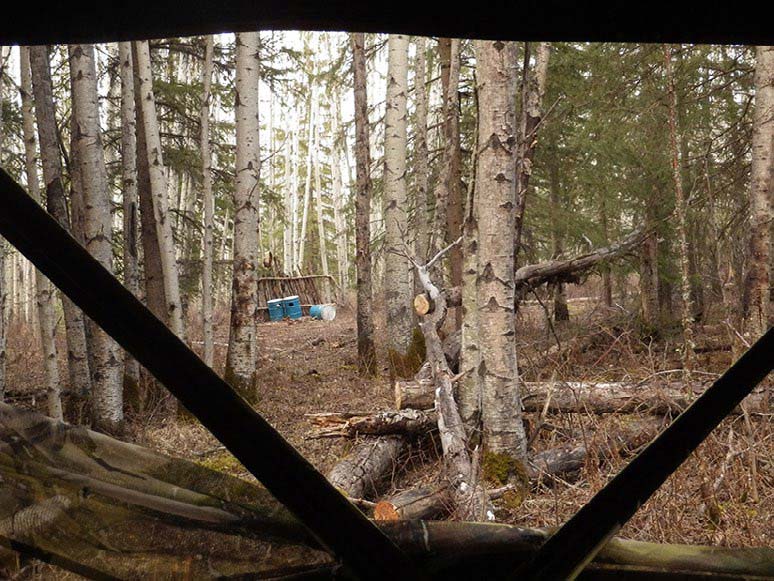
Bait Station Setup
An optimal setup for a bait station is a sparsely treed area that is surrounded by thick, dense cover and located close to a natural travel corridor with ample food nearby. Woods like this allow bears to approach the bait feeling safe. That gives you an opportunity to identify them and ready yourself before they start packing on calories.
As for the actual bait station site, ensure you follow the regulations including distances from dwellings and roadways and proper signage. Your bait container should be a 50-gallon barrel with a removable lid that clamps on securely. Make an eight-inch diameter hole in the top quarter of the barrel’s height. In addition, make a few other smaller holes large enough to slip a cable or chain through to fasten the barrel to a tree. This prevents the bear from rolling it out of place. The removable lid is key to keeping your bait protected from the weather but still allowing you to re-stock your bait barrel quickly and easily. An open-ended barrel provides bears with a grab-and-go option, leaving you without a shot. A smaller feeder hole forces bears to spend more time at the barrel getting food out, providing you with the few extra seconds you may need.
Bow shots require a good view of a broadside bear with his front leg forward. To accomplish this, build a crib or fence to place your bait barrel against. That forces the bear to always approach from either side and stick a front paw into the barrel, exposing his vitals for clean and ethical kill shot. If you’re seeking six- foot bears, cut logs exactly that long and place them around the bait barrel to compare the bear’s length. These small details require additional effort when setting up your bait station. However, they pay dividends by ensuring you don’t have bears sneaking into the bait unexposed or stealing food and dashing back to cover, leaving you without a shooting opportunity. Barrels provide excellent gauges for determining a bear’s size. When its back reaches the top of the barrel, I know it’s a mature bear.
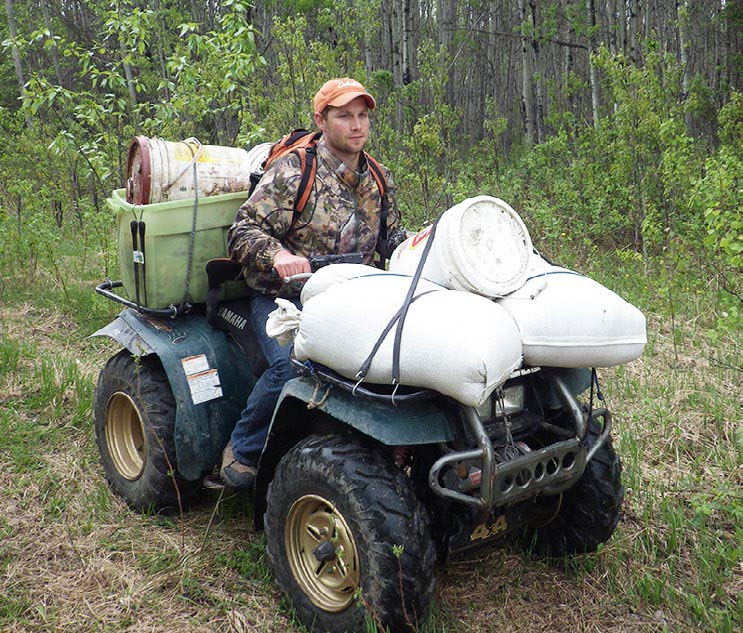
Shooter Setup
Set up your treestand or ground blind 20 to 25 meters away from your bait barrel in some dense bush that provides cover (if possible). If you’re setting up a treestand, place it 16 to 20 feet high, preferably in a spruce tree that provides the best cover and background to blend in with. These are much better than poplar stands. For ground blinds, brush and blend them into surrounding natural habitat so they don’t look abnormal. With either method, ensure you clear any interference from your shooting lanes, right down to the smallest twigs or branches. It’s a delicate balance between having cover and being able to see approaching bears, while keeping enough in place so you don’t skyline yourself or look like a foreign treed object.
Setting up the shooter on the downwind side of the bait is an important step to staying undetected. Bears have an unbelievable sense of smell and can detect smells emanating from bodies. Using scent-eliminating products on your body and your bow hunting clothes will greatly help cover your scent. One setup detail often overlooked is ensuring that you have a safe entry and retreat from the shooting position without passing by the bait barrel. Hunters on baits will sit until nearly 11 p.m. during the spring evenings.
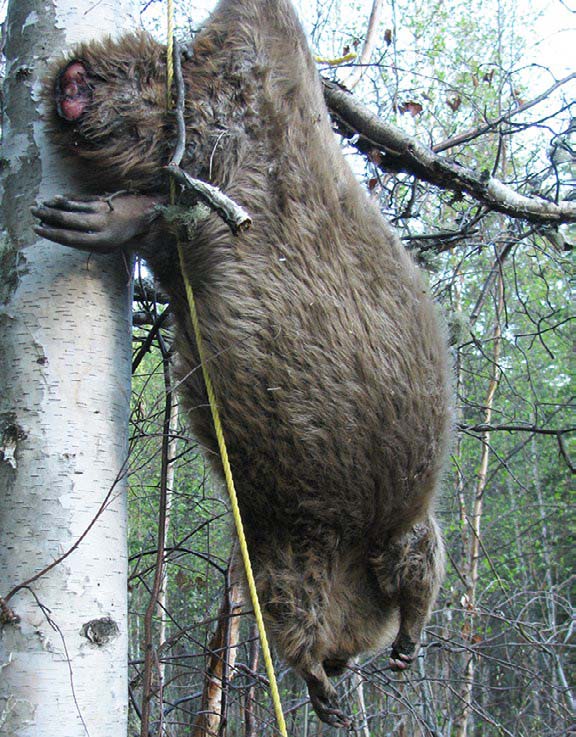
Dark Climb-down
One night last spring, I was targeting a large boar that didn’t come into the bait that evening, though three other boars did. The time had come to get down from my treestand. It was an eerie feeling climbing down to the ground in the darkness close by three hungry bears. I had my bear spray in case of danger, but gladly didn’t have to use it. I was comfortable to get down quietly and retreat to my truck without having to fumble my way around the bait to avoid the actively feeding bears.
If you happen to have a setup on the downwind side of the bait barrel, but you need to go in the direction of the bait barrel to retreat, cut a trail beforehand through the bush, giving the barrel a wide berth. If possible, try not to place the shooter east of your bait because that will make it tough to see during evenings sits.
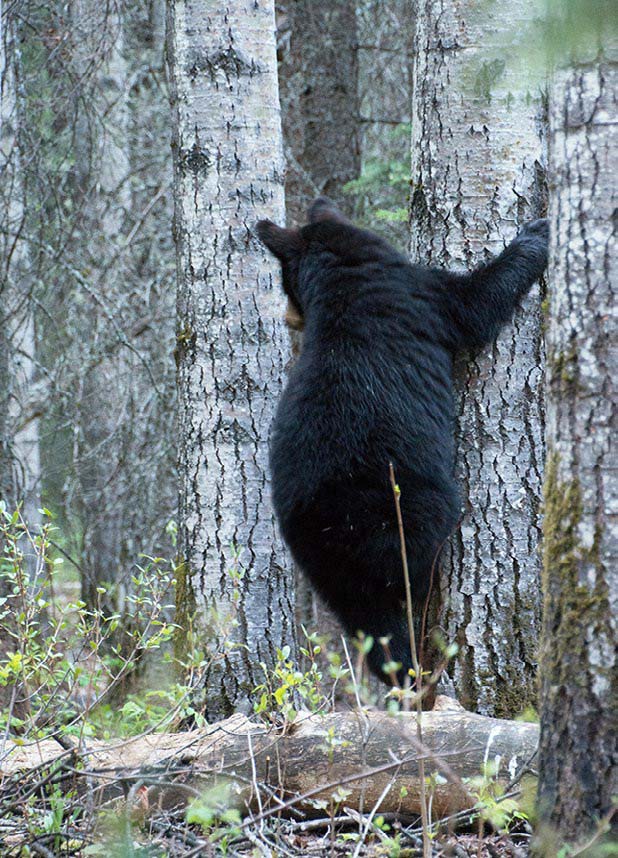
Attract
Being omnivores, bears will eat just about anything. Some of their favorite foods are pastries, popcorn, bread, oats and meat scraps. Again, having a lid on the barrel will protect breads, pastries and popcorn from weather damage and keep your bait attractive. In addition to providing calories, the bait needs to have a strong odor, and the more horrific the smell, the better. Many bear baiters use “stink,” a mix of buckets of rotting fish guts. You can pour this viscous grey liquid mixture around the bait site to attract bears to come in for a closer sniff.
| PRODUCT Mention: |
| Bear Archery Compound Bows |
Another favorite way to attract bears is to use beaver carcasses that are either hung in trees (so they continually produce a smell) or some poured into a bait barrel. Beavers are a favorite food for black bears, so using them is a natural fit.
In addition to meat, I usually have at least one barrel filled with oats that are coated with either syrup, molasses or grease discarded from restaurant deep fryers. These sticky coatings adhere to the bear’s paws and leave a scent trail to and from the bait. Ass the bear roams, the smell attracts more bears.
Every bear and bear area is different, though, and favorite hunter recipes for attracting bears are abundant. If you plan on using multiple bait supplies, use several barrels and add only one type of food to each one. Then see which ones disappear first, second and third. That awareness makes it easy to determine the favorite feast for the bears who are visiting your bait site.
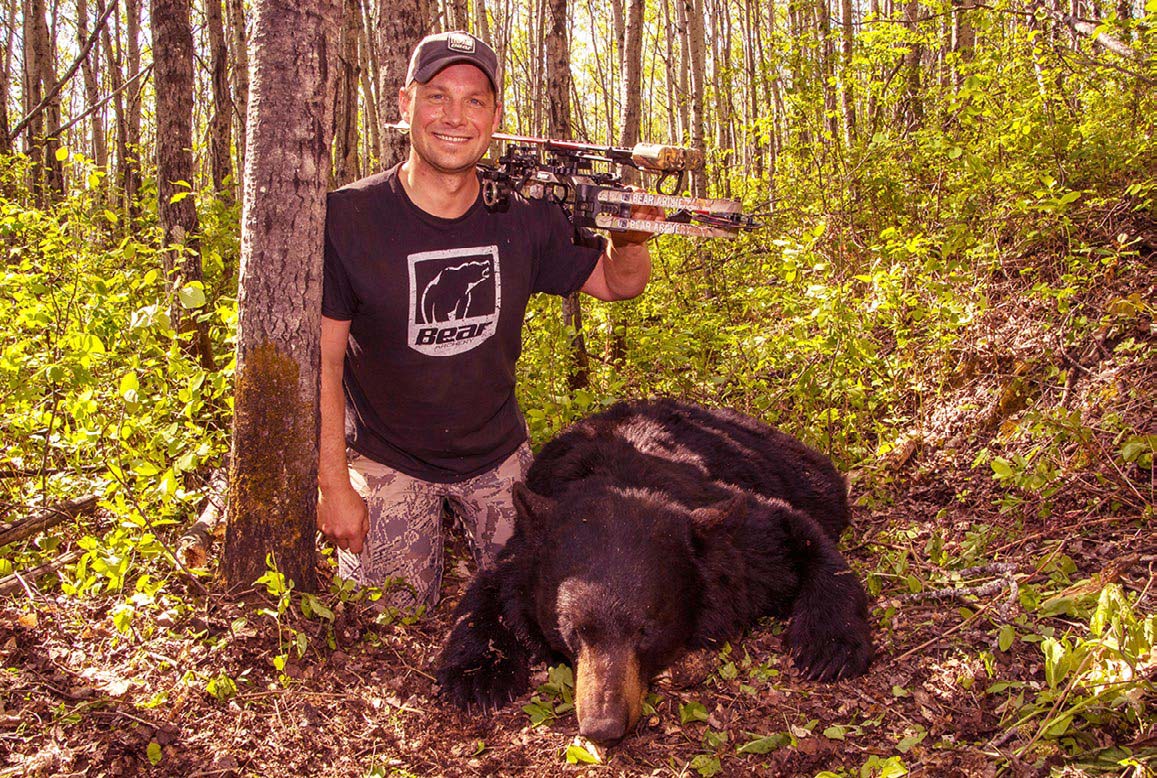
Trail Cams
If you plan on targeting a specific bear, a trail camera is a useful tool to help you identify which bears eat what. For example, sows and cubs might prefer one food over another, but it could be the exact opposite for boars. Each specific bear might even have a favorite. The key is to have a good available supply of their favorite foods on hand to keep your baits topped up. You don’t want the barrels to run dry, forcing bears to seek alternative food sources, and potentially leave the area altogether. By knowing the bears’ favorite foods, you can keep restocking the barrels with those to ensure the bears will be back.
To summarize bowhunting for black bears, start with a WMU known for its high bear population and hone in on quality living quarters and travel corridors. Once you’ve selected an area, properly setup one or many 50-gallon barrels full of smelly, calorie-rich food to attract bears in for a quality shot. Ensure your shooting location is concealed and safe. If you follow these four key aspects, odds are in your favor that you’ll be presented with a quality, ethical shooting opportunity.
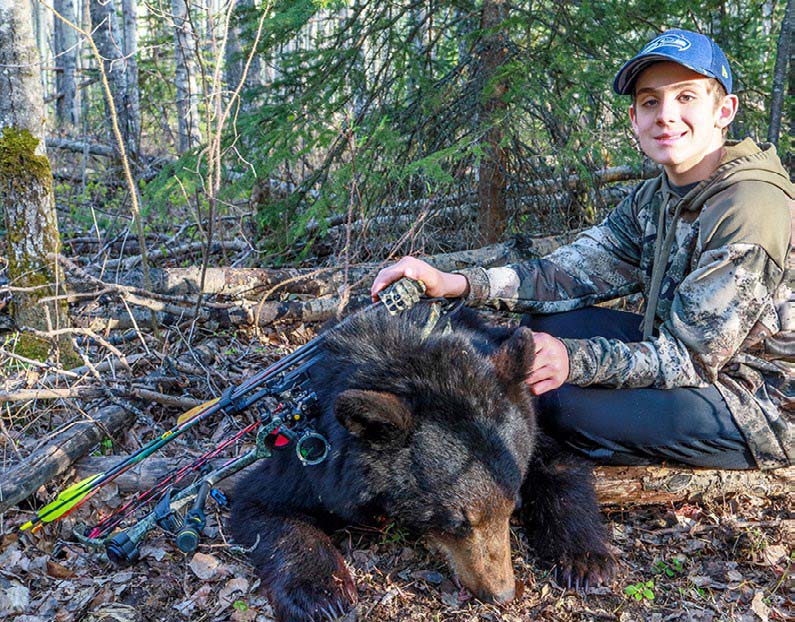
Per our affiliate disclosure, we may earn revenue from the products available on this page. To learn more about how we test gear, click here.





